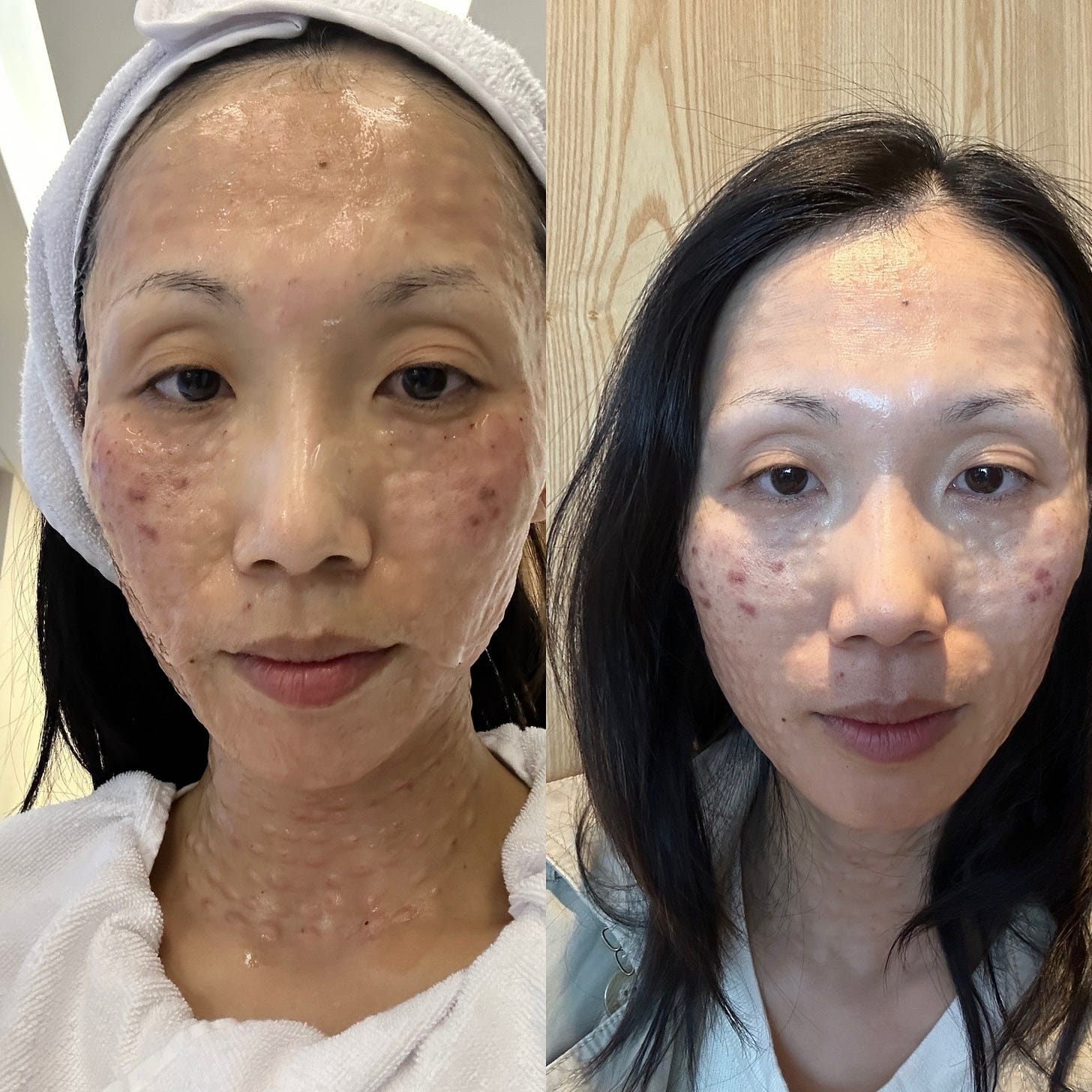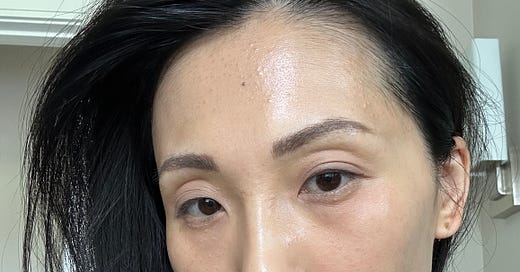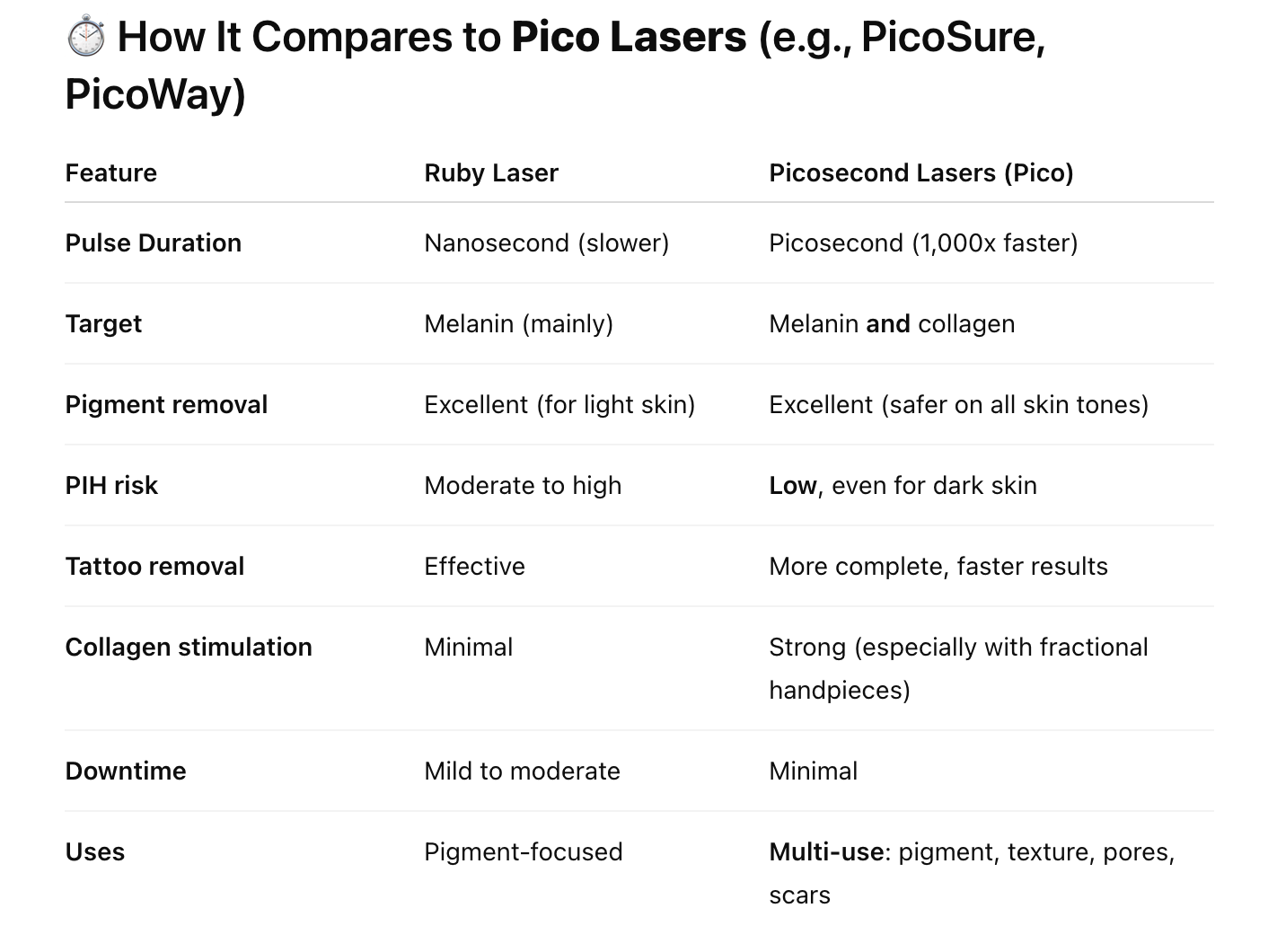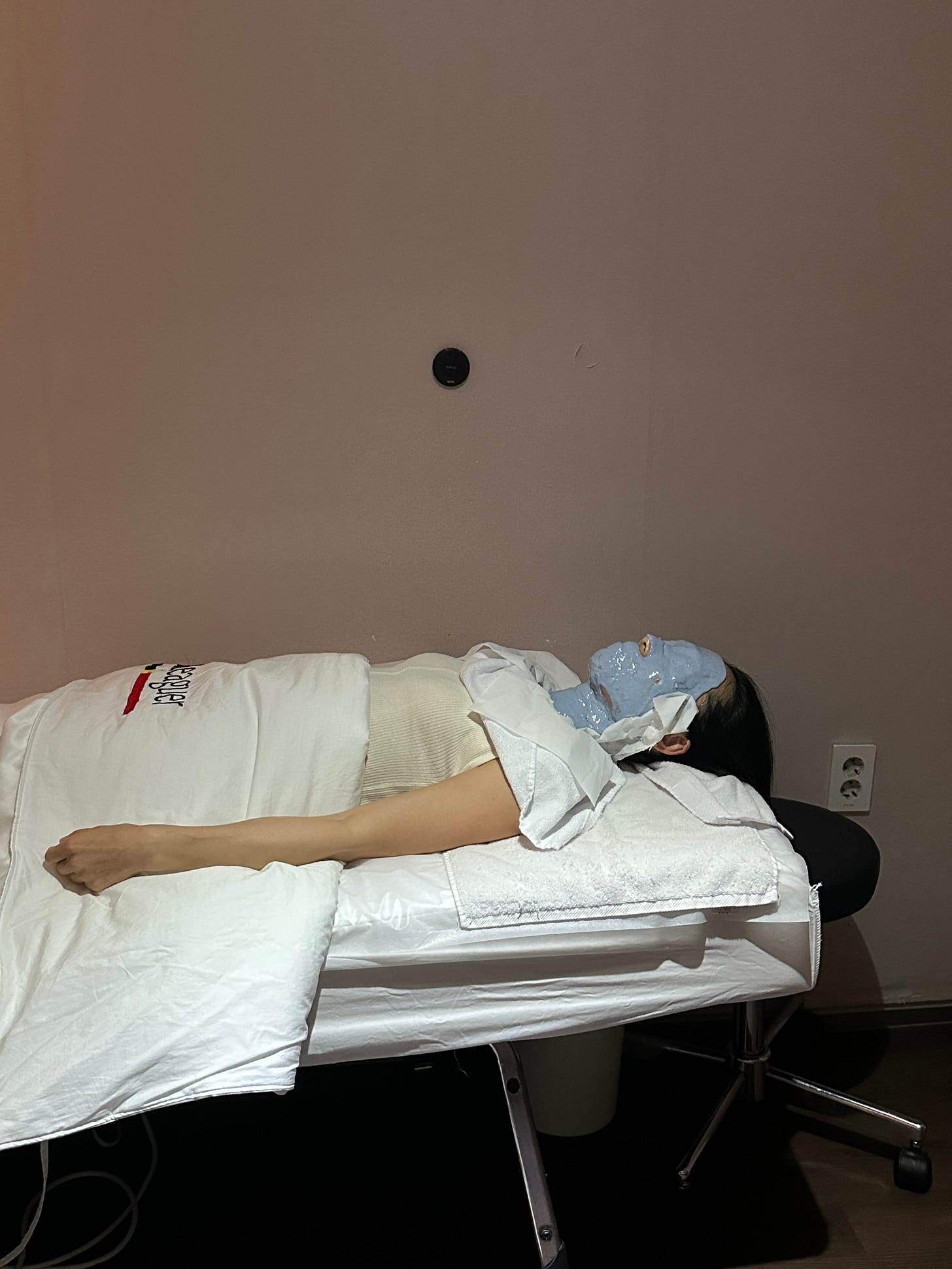Dear readers,
It’s been over a month since I went to Seoul on my 40th birthday trip (read more here and here).
My Concerns and Why I Chose Seoul Over Seattle
How I Chose the Clinic and the Booking Process
The Clinic Visit & Procedures I Chose
1. My Concerns and Why I Chose Seoul Over Seattle
You can read more about my perspective on aging in this post and the specific procedures I had done in Bangkok with my friend Dr Pang in February of this year in this post.
Having had an initial experience in Bangkok, and learned a lot about various treatments from Dr Pang, I had very specific treatments in mind for the next session. I wanted an additional session of Sculptra, a bio-stimulatory filler that is different from traditional fillers (see below for comparison table courtesy of ChatGPT), as it is typically recommended to do 2-4 sessions, each spaced 2-3 months apart. Since I got my first session in early February, a second session in late April was perfect timing. I wanted to avoid traditional fillers and have a more natural look in addressing collagen loss in my face. However, I cannot recommend Sculptra unconditionally as overdosing on it or being injected by someone who is not skilled enough can lead to drawbacks, especially if you think you’ll be getting a facelift later in life; I recommend listening to this podcast episode by three board certified dermatologists for more information. I didn’t know this until after I had had my first session of Sculptra, but since I’m not going to overdose on it and I was going to top board-certified dermatologists in Thailand and Korea, I felt reasonably confident that there was little downside to a second session.
I was also curious to try Rejuran, the [in]famous salmon sperm derivative (PDRN) that has been going viral on social media. I already knew I wanted Rejuran HB, which is a less painful version than Rejuran Healer (see below for ChatGPT’s breakdown of the four types of Rejuran).
I was also interested in doing an additional session of laser to address my hyperpigmentation and melasma; Dr Pang had told me that the one session of pico brightening laser she gave me in Bangkok wasn’t enough, and that multiple sessions are most effective.
I’ve explained in my Thai glow up post why I chose to do my procedures in Asia. Aesthetic dermatology is a very competitive industry in Korea, and there are many clinics, in part because Korean women do beauty treatments on the regular (they get them like we get mani/pedis). The medical services industry is not as heavily regulated in terms of malpractice as in the United States and beauty is much more of a national cultural fixation than almost everywhere else in the world; as a result, there are more innovative treatments and lower prices. There is a downside to this, of course, that I need not explain here (but I can in a future post!).
I also feel comfortable navigating a country in which I am not the native speaker, which I’ve been doing for decades. I also have first or second degree connections to nationals of Thailand and Korea, through whom I can find excellent dermatologists and clinics. This is not the case for many people, and so I recommend using a trustworthy beauty concierge such as Beauty Day Korea or Aneue to book if that is your situation. Also, dermatological services in Korea can qualify for a tax refund!
2. How I Chose the Clinic and the Booking Process
My friend Aily and I, the resident ENFJs of our friend group, were in charge of booking appointments for the girls’ trip to Seoul. Aily and I are also the two most enthusiastic consumers of beauty products, and have similarly discerning/picky mindsets. Several months before our trip, we sent each other Instagram reels and profiles of influencers and Seoul-based clinics, and discussed pros and cons. I went down Reddit threads about popular foreigner-friendly clinics in Seoul and made a list, but honestly I kind of felt uncomfortable because I just had this sense that they would be like factories. If you’re catering to foreigners, you’re likely to 1) overcharge and 2) treat the experience like a commodity.
I asked a good friend who makes frequent business trips to Seoul if she had a recommendation for a clinic that locals actually visit. As it turns out, her friend from college, a native Seoulite, recommended a clinic that she’s been going to herself every few months. The clinic’s website was in Korean and not foreigner friendly - great to me because it showed me that its customer base was Koreans, not foreigners. The Instagram page had 5k followers, which was not a lot compared to some viral foreigner friend clinics - another good sign. I looked through the posts and they featured services beyond just the popular treatments, including some that I had never heard of - yet another good sign. That’s where I read about the ruby toning laser, which I had never heard of in the US (see below for ChatGPT’s analysis of how it’s different from pico, which is popular in the US)
I contacted the clinic on WhatsApp, where they run an English account with their in-house interpreter. We booked in early March for our April 25 appointments and there was good availability. Since multiple friends wanted to go, we set up consult appointments in groups of two. The clinic asked us to fill out basic information about ourselves and our skin concerns, . The process was quick and smooth. My friend did ask me to confirm that the in house English interpreter would be present that day, as that is not always the case. They also Spanish, Portuguese, Japanese and Chinese interpretation.
3. The Clinic Visit & Procedures I Chose
Our appointment was on a Thursday at 10am, and when Aily and I arrived, the clinic had just opened and only a couple more patients trickled in after we arrived. The building is located in Gangnam, near many other clinics, and easy to find. The inside was clean and modern, and all the staff were professionally attired. The interpreter, Helena, greeted us, and we realized quickly that she also spoke Mandarin, so we ended up actually speaking to her in Mandarin, as she was more fluent in it than English (but her English was great too!). She’s also fluent in Spanish, Portuguese, and Japanese, hence the ability of the clinic to provide these interpretation services.
Helena took us to a consultation room, where we met with the head nurse/practice manager, who asked us a series of questions about what we’re interested in, to gauge whether we wanted to see the doctor or not. Since we wanted to consult with the doctor before deciding on our services, she called in Dr Lee, one of the two dermatologists in the practice. Dr Lee is in his fifties, amiable and also conversationally fluent in Mandarin and English, but he prefers to have the interpreter on hand to make sure that nothing is lost in translation.
After explaining our concerns to him, he recommended a long list of treatment options. For me, he recommended pico + ruby toning laser, Thermage, Rejuran HB, Botox and Juvederm. However, I pushed back on Juvederm, saying that I preferred the more natural look of Sculptra. Interestingly, the clinic does not have Sculptra in stock, and so they had to special order it for me for Saturday, when I would bring my parents back to the clinic. I asked Dr Lee why he didn’t recommend Sculptra, and he said he felt there were safer options. I later asked my friend Dr Pang in Bangkok why Dr Lee would say that; she said that Sculptra has a long safety record, and that Koreans may not push it because have their own version of Sculptra called Ultracol and Sticol that is produced domestically. Korean nationalism in aesthetic dermatology has its pros and cons, and I could write a whole other post about it!
Anyhow, I decided on pico + ruby laser, Rejuran HB and Botox for my face that day, and pico + CO2 laser for a keloid scar on my right arm. I didn’t add Thermage because I like to limit the number of procedures to 3-4 each time. The clinic special-ordered Sculptra for Dr Lee to inject on Saturday. Botox was not on my original wishlist, but Dr Lee assured me that he could use light touches of botox on my glabella (area between eyebrows) and corners of eyes to reduce the appearance of fine lines. I told him, “I don’t want American resting botox face” and he got it 😂. I appreciate that Dr Lee wasn’t pushy when I told him I didn’t want Thermage and Juvederm - I’ve heard that some of the touristy clinics can feel very sales-y.
After the consult, I went in to have my face assessed by this machine that all Korean clinics have. It scans your face and tells you your actual skin age, your main issues, etc. Surprisingly, my skin age was 36, and my main issues were wrinkles, some hyperpigmentation and very dry skin. The only surprise to me was how dry my skin was - both inside (internal hydration) and out (dermis). I need to drink more water and use more moisturizing skincare! I had always thought I was combination skin since I occasionally get pimples in my t-zone, but I realized that I was probably getting them because my skin was too dry. When your skin is dry, your sebaceous glands may overproduce oil to compensate, and this excess oil can mix with dead skin cells and clog pores → acne breakout (ChatGPT). By the way, I’ve been doubling up on hydrating skincare since my return from Korea and I have had ZERO pimples, whereas before Korea, I was averaging 1 pimple per month.
After the skin analysis, Aily and I were conducted to a treatment prep room where we had numbing cream slathered on our face. I waited about an hour or so as another friend and Aily got their treatments before me. Dr Lee was the only doctor on call that day, so he was taking patients one at a time. Dr Lee did the lasers first, and when he applied the ruby toning laser, I could smell burning, which he said was from my facial hairs being singed by the laser 😬. Then he administered Rejuran HB, and botox was last. Honestly, the most uncomfortable procedure was botox, because of the stinging when it’s injected. In the US, the original Botox is the go-to choice, but I was offered multiple options, from which I chose Xeomin, which is the purest form and therefore your body develops less resistance to it over time (see below for ChatGPT’s comparison of popular botox types)
Dr Lee also administered my Sculptra injections on Saturday and my goodness, he was SO SKILLED. I barely felt anything and he was super quick. Dr Pang was also good, but I could tell Dr Lee has had more experience - he is a master of the needle.
After my treatments on Thursday, I was taken back to the treatment prep room and underwent a lengthy post-procedure protocol. Red light therapy and a cooling modeling mask helped reduce skin inflammation. See below for photos of my skin right after procedures and before recovery protocol, and then again after recovery protocol.

We were given treatment care handouts for each type of treatment, and I decided to purchase a cream and face masks made by the clinic to help with recovery. We paid via credit card, and were issued forms for tax refund. We left the clinic after 2pm, so the whole process took about 4 hours.
Here’s how I would rate the pain of each procedure, knowing that I have high pain tolerance (I delivered my first baby with no pain meds):
Pico/ruby toning laser: 1/10 (I would give it 0 if possible)
Rejuran HB: 3/10
Sculptra: 4/10 (but I felt it was more of a 7/10 in Bangkok)
Botox: Hard to say, because there was very little pain (1/10) but I hated the stinging, which is brief.
I do think the skill of the administering injector has a lot to do with how much pain you feel, and of course every person has different pain thresholds, so it’s hard to trust another person’s pain ratings. However, Dr Lee is incredibly skilled at injecting, so I think the pain you experience there will be less relative to many other injectors. He and his colleague are in some Korean dermatologist rating system and are ranked the top 2% in their field.
That’s it for today! Next week I’ll share more thoughts on the results and pre/post pics!
Below is a preview of how good my skin looks now 😍.









